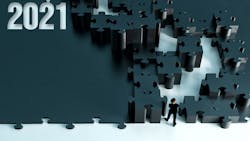As we emerge from 2020, if not from all of the problems that have besieged us, it’s useful to ask if we’ve learned anything this year. As we gaze toward 2021, the answer to that question may define us.
There are some glimmers of light against the darkness of the year. We changed the way we did business, and we did it on the fly. We quickly implemented technology when and where it was needed. It didn’t require fighting through levels of corporate wrangling to find and deploy solutions designed to maintain social distancing in our plants, to automate operations to overcome manpower shortages and to provide the protective equipment needed to keep workers as safe as possible.
We asked an enormous amount of our workforce in 2020. Most of those stories were drowned out by the political and social upheaval these measures required, and yet the workers persevered. Our workforce saw the value to themselves and their community. They understood the sacrifices it would take. Manufacturers of all sizes moved forward and helped drive manufacturing back into growth mode by summer.
We also saw the weaknesses in our system. In particular, supply chains were challenged and stretched and recreated, and that work isn’t done as of yet. Regrowing the global economy will take a reimagination of how we move from raw materials and parts to finished goods, and from there to delivery to consumers.
Consumers have changed as well. Boxes are delivered to our front stoop. We still are learning the value and dangers of an on-demand economy, and that too will take some reconciliation once the pandemic is better under control.
We have benefitted from our technology improvements and our determination to stay strong despite the pandemic and the struggles it created. Did we learn anything? It’s a fair question; we’re far from out of the woods, and yet there remains, remarkably, a ray of hope.
But when you’re in the middle of the woods and you cannot see the way out, the first thing you need to do is orient yourself. You need to find your direction before you can hope to get out of the woods. Going backwards isn’t really an option. Heading off in just any direction keeps you moving, but may not get you any closer to the edge of the woods. The only way to get where you really want to go is to find your best path and keep moving forward.
About the Author
Bob Vavra
Senior Content Director, Power & Motion and Machine Design
Bob Vavra is the Senior Content Director of Power & Motion and its sister publication Machine Design. Vavra has had a long career in publishing, media and events. He has covered all aspects of manufacturing for the past 20 years and is a regular attendee at events such as IMTS and Hannover Messe. Vavra is also a sought-after webcast moderator and event emcee, and has presided over events in the U.S., Germany and China.

Leaders relevant to this article:
